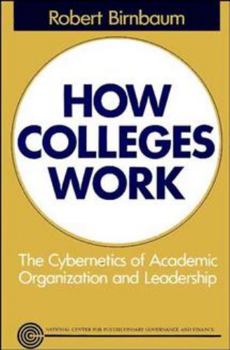How Colleges Work: The Cybernetics of Academic Organization and Leadership
Select Format
Select Condition 
Book Overview
"One of the best theoretical and applied analyses of universityacademic organization and leadership in print. This book issignificant because it is not only thoughtfully developed and basedon careful reading of the extensive literature on leadership andgovernance, but it is also deliberately intended to enable theauthor to bridge the gap between theories of organization, on onehand, and practical application, on the other."
--Journal of Higher...
Format:Paperback
Language:English
ISBN:155542354X
ISBN13:9781555423544
Release Date:September 1991
Publisher:Jossey-Bass
Length:288 Pages
Weight:0.88 lbs.
Dimensions:0.7" x 6.1" x 9.0"
Related Subjects
Administration College & University Education Education & Reference Education TheoryCustomer Reviews
4 ratings
How Colleges Work
Published by Thriftbooks.com User , 15 years ago
Excellent overview of the various different college structures. Author worked hard to create analogies for how college systems were linked, but after getting into middle and later chapters the anlogies made some sense. A good introduction to, as the title says, how colleges work.
The basics of organizational structures
Published by Thriftbooks.com User , 16 years ago
The author provides a thorough discussion of the four basic organizational structures in higher education. What I found most helpful is that he also provides strategies to help academic leaders be efficient and successful in each of the organizational structures described.
Review on How colleges work
Published by Thriftbooks.com User , 16 years ago
This book is one of the most interesting books I have read. it is written persuasively and in a clear language. That it uses hypothetical cases also makes readers clearly see what is happening on the ground practically.
A General Theory for Higher Ed. Administration
Published by Thriftbooks.com User , 23 years ago
A highly theoretical text; Birnbaum takes the reader through a well-planned out dissection of the common systems and "loops of interaction" in a college or university setting. He mainly focuses on the division of power between administrators and faculty, and gives frameworks for how these groups may interact with each other, or within their group. Birnbaum shows the reader 5 fictional samples of institutions of higher education: collegial institutions, bureaucratic institutions, political institutions, and anarchical institutions. In his final section of the text, Birnbaum gives his idea of the ideal institution: the cybernetic institution, which encompasses characteristics of the four other types. I was a little disappointed that Birnbaum did not manage to tie up all the loose ends or to present a solid recommendation about how to create positive change in an institution of higher education. His theories of open and closed systems, dual control, and tight vs. weak coupling, however, are very insightful and well thought-out. A good basic framework.





